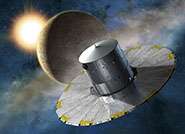Countdown to the galactic census: Europe's billion-star surveyor is ready for launch

On 20 December 2013, Europe's billion-star surveyor is due to be launched into space where it will embark on its mission to create a highly accurate 3D map of our galaxy.
By repeatedly observing a billion stars with its billion-pixel video camera, the Gaia mission will allow astronomers to determine the origin and evolution of our galaxy while also testing gravity, mapping our inner solar system, and uncovering tens of thousands of previously unseen objects, including asteroids in our solar system, planets around nearby stars, and supernovae in other galaxies.
The Astrophysics Group in the University of Bristol's School of Physics has received a grant from the UK Space Agency to further develop the data-handling software authored by Dr Mark Taylor to access the data from the Gaia mission.
Gaia will make a comprehensive survey of the positions and motions of thousands of millions of stars across the Galaxy. This is expected to reveal stellar streams indicating how it was assembled, and chemical signatures showing how the stellar populations have changed over its entire history.
Gaia will map the stars from an orbit around the Sun, near a location some 1.5 million km beyond Earth's orbit known as the L2 Lagrangian point. The spacecraft will spin slowly, sweeping its two telescopes across the entire sky and focusing their light simultaneously onto a single digital camera, the largest ever flown in space.
Gaia data will be processed and analysed ready for release to the scientific community and public at six data centres, including one in the UK, operating software developed and tested by a consortium of 400 people across Europe, including some 50 people at six Institutes in the UK (Cambridge, UCL-MSSL, Leicester, Edinburgh, The Open University, STFC RAL Space and Bristol).
Professor Gerry Gilmore, from the University of Cambridge and UK Principal Investigator for Gaia, said: "Gaia will be a revolution in our knowledge of the local Universe. For the first time we will have a fair sample of what is out there, where it is, how it is moving, how unseen (dark) matter is distributed, where and when stars formed and where and when the chemical elements of which we are made were created."
Provided by University of Bristol



















